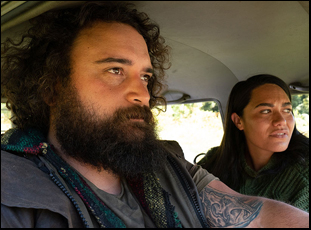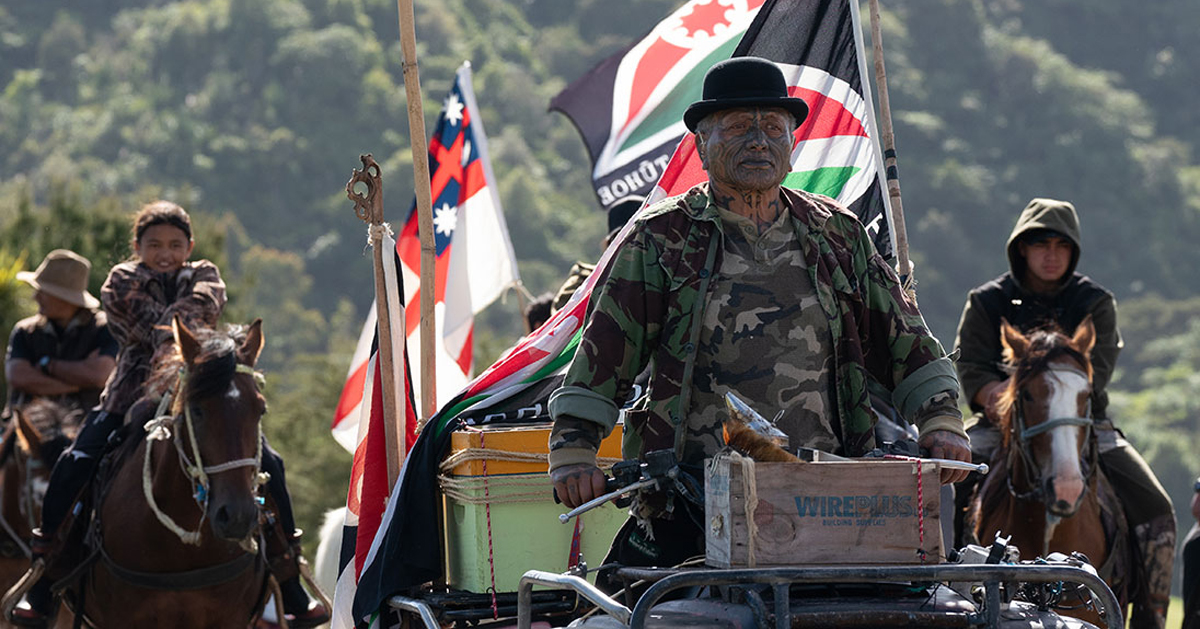Police chief is just one of the many responsibilities of “Taffy” Tāwharau (Cliff Curtis) in “Muru,” seemingly more helpful to his community as a bus driver to shuttle children to school in the morning and the town’s elders once the kids have stepped off. A gun is not far from his reach, but it hardly seems like a necessity in the town where the worst crimes are some teenage vandalism, though as the home of the Tūhoe people, it isn’t immune from outside threats as Tearepa Kahi’s stunning thriller depicts, announcing itself from the outset as not a recreation of raids that have been conducted on the Māori Iwi from colonizers in both 1916 and 2007, but a response. With the cooperation of the Tūhoe from the very conception of the project, it is a powerful one, imagining a push from the government to brand the locals as domestic terrorists in an effort to seize their land, alleging from a specious bit of surveillance that Tame Iti, a leader in the Māori community has an arsenal of weapons, though they’re strictly intended for self-defense.
You can understand why the preparation is necessary when the military is dispatched to the Roatoki Valley of the Aotearoa, enlisting regional law enforcement in their cause, though Maria (Simone Kessell), who leads the patrol, starts to become skeptical because of the level of aggression with which the special forces pointman Gallagher (Jay Ryan) is pursuing the raid. “Muru” may join a tradition of suspenseful classics where a town under siege bands together to stave off a threat seemingly so much bigger than themselves, but it is deeper and more profound when it stars the same Tūhoe community that has endured such abuse in the past and the film itself becomes a form of resistance. Filled with passionate action from its jaw-dropping chase scenes to crossfire involving shifting loyalties where the stakes couldn’t be higher, the film shakes things up on screen and seems likely to shake them up off screen as well. With the film making its international premiere at the Toronto Film Festival this week, Kahi spoke about what inspired him to take on the sprawling thriller after spending much of the last decade making documentaries, drawing strength from the Tūhoe community and getting the most out of a month-long shoot.

It’s a huger thing than I thought it would be, but really I’m a father of four kids. My children all grew up speaking Maori. Tame Iti has been a hero, but he’s also a family friend. My wife is the producer, so we were already committed by the events of 2007 in terms of allowing the time to take place where we could build a vision that could draw in and draw on the relationships that we had to speak truth to an event beyond the headline and actually really explore and hope to reveal the impact of this story and what this story really means and who it really hit and give a face and an identity to it all, so that’s what drew me in.
When you’re making a film about a community and its’s set in the same area where these events took place, so you worry about retraumatizing people given what happened?
It’s all I ever worried about, and we asked ourselves that question every single day. I was with Tame two years before we went into principal photography, going in, looking around, forging relationships, sharing the vision, providing clarity, ensuring the duty of care, and making sure that this isn’t something that [is seen as] trying to create a little professional stepping stone. That’s not what this is about. This is about their kids and our kids and understanding the depth of impact and building this as a protest piece that prevents this from ever happening again, so retraumatizing could easily have happened had that not been the true north of this project.

Yeah, early on in the scriptwriting process, it was really about understanding the impact of a single day and I was guided by the people of Tūhoe at a meeting we had where I was seeking their blessing and someone from within the house said, “Is this about one day”? I said, “Yes, and I’ve written the script and I think it’s really good.” And she said, “How can this be about one day when the government have done this to us over a century”? That really made me stop and think and go, “Well, I’m committed to this, the script’s really good.” [laughs] But it guided me because if you resist the voice of home, then go somewhere else [and not make the movie]. But if you listen and embrace what’s being said and you can be guided by that, it allows for a grander emotional scope and context, as well as exploring historical memory and how we might be able to thread that into this piece. Now that sounds like a lot of gymnastics, but fortunately we found a form where it wasn’t, and I think it’s woven together in a way that it speaks as one piece.
It’s so interesting it’s a part of another lineage of the siege thriller genre, but here it transcends those trappings because of the real history that’s infused into it. Did you actually find that story structure helpful?
What’s really important here artistically and as a father is to ensure that this story never happens again, so in terms of borrowing or integrating these other elements, it was more about prevention and drawing these characters onto this chessboard in this way. It’s an ensemble piece and there are a lot of characters who I hope reach a point of transformation that provides clarity and the fact that we can take on this burden and responsibility, but also create a big screen experience that’s being truthful to the culture – to these people and to Tame – but also to the fact that we’re making a movie here. So it wasn’t so much a case of borrowing from the genre, but drawing full conclusions and testing the relationships and the loyalties of our characters.

Cliff has been a huge supporter of me since in my whole screen story journey, so he’s been a huge big brother and we’ve both come up the tree of Merata Mita, who is an important mentor to both of us, so we have many relationships and the three of us – myself, Cliff and Tame have a good relationship, so there was no one else for Taffy, and as there was no one else for the role of Tame Iti, it had to work between the three of us, and fortunately it did. And we worked really hard. Cliff offered so much and contributed in so many ways beyond the screen realization of Taffy. He was instrumental in the story process as well.
Since you mention Merata Mita, she too traversed between documentaries and dramas. Does one format inform the other for you?
For me, the commitment that I’ve got to my kids is to tell them stories and the story chooses the form. Sometimes the best way to tell a story about Dalvanius and the Song of Poi E through documentary around Dalvanius and sometimes the best way to bring the story of Tame Iti to life is through this fictional action drama thriller with that unveils everyone’s humanity and relationships to each other. That’s the way I look at story – it has a real form, and when you can find that form now you can tell the story.
This lets me pay you a giant compliment – you show a real mastery of geography when it comes to the big chase scenes. Logistically, were those challenging to tackle?
We shot this film in 29 days. Being on location, my role and part of my style is to listen to what’s being said and if the valley is saying something, then you listen to the valley. So finding the right contour and the right places for a river bend, for a helicopter landing, for a drone, for a truck flip — all of these things was about spending time there. And because I had spent so much time there and mapped it out so well and we had such a great crew and cinematographer, we were able to execute this in quite an economic schedule. It meant that a lot of our cast…they didn’t suffer, but they were really holding on. [laughs]

The happiest intended accident was thrown away — I had written an ending that revolved around the similar characters, but it was done in a way that was obvious and through the process and what happens through a quick shoot, different characters demand more time. And I’m not just talking about actors, but about the characters on the screen. They just demand a little bit more time or attention, so we landed on an ending that felt so much more character truth that was away from a big fancy ending by a writer that had written over a period of time to something much more intimate and emotionally resonant that actually grew out of the process of our filming.
I understand that you’ve actually been able to take the film to a number of Tūhoe communities even before coming to Toronto. What has the experience of just bringing this film out been like?
When you talked about retraumatizing before, because we did not shoot this film on a set, we shot this in the backyards, on the dirt roads, in the open houses of this community, I’ve only ever been worried about two things – one was that aspect of the potential for retraumatization, and the second was that the most important screening is the screening that we do for Tūhoe. After the screening, one of their tribal elders said to me, “Boy, this is the best depiction of 1916 I’ve ever seen.” Because he understood thematically, historically, culturally, cinematically, what was really underpinning and driving this — the motivation to bring this story to our country and through the Toronto Film Festival and bringing Tūhoe to an international community.
“Muru” will screen again at the Toronto Film Festival on September 17th at 6:15 pm at the Scotiabank.




